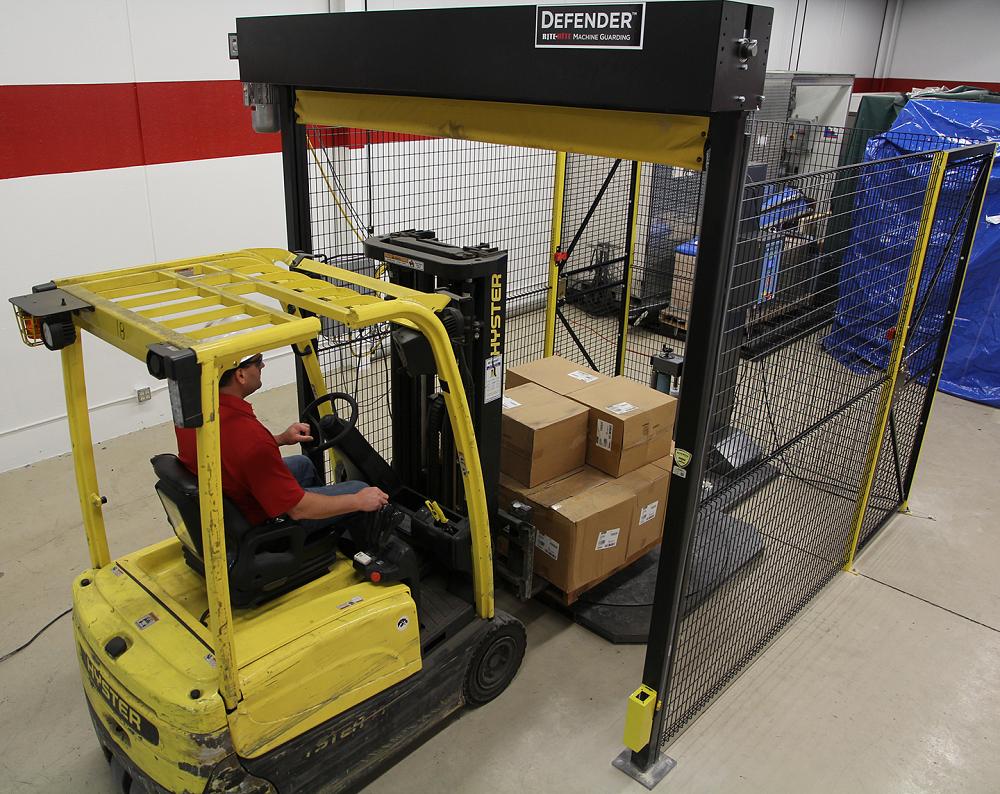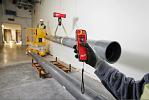National Sales and Marketing Manager
- FMA
- The Fabricator
- FABTECH
- Canadian Metalworking
New Safety Standards Also Boost Efficiency
New regulations create more standardized guidelines in many jurisdictions
- By Eric Esson
- June 9, 2016
- Article
- Automation and Software

Safety systems are available that combine safety interlock switches with a movable physical barrier that helps contain weld flash, flying debris, mist, and other containments. Photo courtesy of Rite-Hite Machine Guarding.
Industrial safety standards in North America have undergone sweeping changes in recent years. While most facilities’ engineers have taken note of these regulatory shifts, those who haven’t might find they are no longer up to code – risking costly fines, injuries, and loss of employee morale.
Advanced metalworking facilities require highly trained employees. Therefore, it’s more important than ever that those plants adopt new safety standards that are keeping up with their new technology. One of the best ways to ensure a safe work environment is by conducting a thorough risk assessment, especially when new automated processes have recently been added.
This isn’t just a suggested best practice, though; thanks to the new CAN/CSA Z434 standard that was adopted in 2013, proper risk assessments are now mandatory when automated equipment is added to a material handling operation.
Synchronizing Standards
This new standard references ISO 10218-1 and -2, which address robots, robot systems, and integration. The revised CSA Z434 was written in collaboration with the Robotics Industries Association (RIA) in the U.S. to be compliant with international standards already in place in Europe, making life easier for manufacturers and end users.
CSA Z434 requires superior hazard identification accounting for not only robot motion, but also the material handling task being performed. Additionally, it requires validation and verification of the safety systems employed and of the designs that incorporate protective measures for the robot cell and the operator. Because every robot system is different, requiring risk assessments is an important step in protecting employees.
The biggest changes we are seeing in the new CSA Z434 industrial robot standard have to do with safety-rated motion and allowing for advanced programmable safety devices to be utilized. This acceptance of programmable safety devices allows software to be programmed with safety-rated control of various aspects of the robot’s function, such as limiting the area in which the robot operates and the speed of robot motion. This is a departure from older standards in that programmable safety controls were not allowed.
Because of technological advances in safety controls, these long overdue programmable safety controls can now be safely implemented. In the past, engineers designing these systems guarded for the maximum space, speed, and load of the robot. With these changes, the physical footprint of new robot cells should shrink. Coupled with the proper point-of-interaction safety devices, significant floor space savings.
Safety Becoming Quantitative
One of the biggest regulatory shifts in recent memory occurred in 2012 with the move from EN 954-1 to ISO 13849-1 and EN 62061. Support for this change began in 2007, but its opponents were able to put the change on hold in 2009 and kept it there until 2012. While approval of this harmonized standard was a hotly contested fight, it is now here to stay. Fortunately for those in charge of safety, best practices and market-ready systems already exist.
At its core, ISO 13849-1 provides a clearly defined set of rules to follow when designing the safety system for industrial machine controls. Officially defined as “safety of machinery, safety-related parts of control systems, general principles for design,” this regulatory shift became necessary because of increasingly complex manufacturing processes using robotic and automated technology, forcing safety control systems and methodology to keep pace.
The ISO 13849-1 standard is more quantitative than EN 954-1, applying common sense and forcing facility managers to validate their safety systems. Conversely, EN 954-1 was conceptual and only required facilities to apply safety devices (controls) properly specifying nonprogrammable, out-of-date technology.
As manufacturing processes become increasingly more intricate, more complex systems will be needed to monitor their operation and keep machine operators safe. Automated processes, robotics, and even time-tested methods all require considerable attention to ensure those processes can proceed both efficiently and safely. Like EN ISO 13849-1 before it, CSA Z434 is ultimately resulting in much safer manufacturing environments because it accounts for the regulatory gaps that were starting to show in the older standards.
Increase Safety and Floor Space
Automated barrier doors are quickly establishing themselves as a popular safety device option for points of interaction. While the main purpose of these doors is to contain fumes, sparks, smoke, mist, flying debris, excess noise, and other common manufacturing process byproducts, they can minimize the physical footprint of the robotic cell by eliminating the safety zone that incorporate light scanners or light curtains need. The most advanced roll-up automated barrier doors incorporate high-speed, high-cycle technology, as well as PLe hold-down mechanisms and safety-rated noncontact interlock switches and controls.
For material handling safety, many automated barrier doors are just found on one (or two) sides of a complete workcell that incorporate fixed perimeter fencing. This fencing serves as a physical barrier to keep employees away from potentially dangerous operations, such as automated stretch-wrap machines. Meanwhile, the automated barrier doors provide quick and easy access when the machine has safely powered down.
Most automated doors function from the top down, but some are designed to operate from the ground up. This design allows machine operators to easily interact with the process utilizing overhead cranes to load and unload large, heavy parts. They are also an option for interaction points with a limited space.
New Standards for New Technology
Now that these new standards are matching up better with state-of-the-art technology, they
will help keep workers safe when followed and will actually improve efficiencies in facilities throughout Canada and North America.
As regulations like CSA Z434 are adopted, it is important to keep up on the latest and greatest safety technologies available to match the right product with the process, taking not only potential machine hazards into consideration, but also the task being performed. Advances in design and available technology make automated barrier door systems an ideal option to guard a machine and protect operators, ultimately increasing productivity and the level of safety in facilities for years to come.
Eric Esson is national sales and marketing manager, Rite-Hite Machine Guarding, 414-355-2600, www.ritehite.com.
About the Author
Eric Esson
Frommelt Safety Products
8900 N. Arbon Drive
Milwaukee, Wisconsin 53223
866-852-1500
subscribe now


Keep up to date with the latest news, events, and technology for all things metal from our pair of monthly magazines written specifically for Canadian manufacturers!
Start Your Free Subscription- Industry Events
MME Winnipeg
- April 30, 2024
- Winnipeg, ON Canada
CTMA Economic Uncertainty: Helping You Navigate Windsor Seminar
- April 30, 2024
- Windsor, ON Canada
CTMA Economic Uncertainty: Helping You Navigate Kitchener Seminar
- May 2, 2024
- Kitchener, ON Canada
Automate 2024
- May 6 - 9, 2024
- Chicago, IL
ANCA Open House
- May 7 - 8, 2024
- Wixom, MI




















